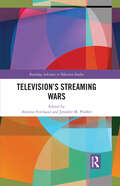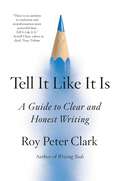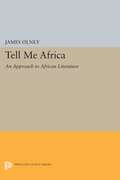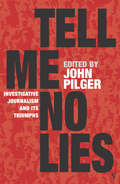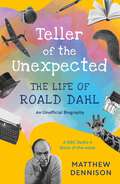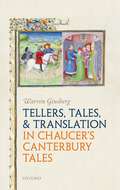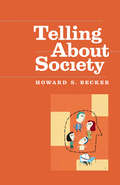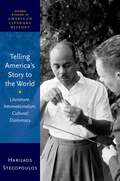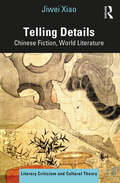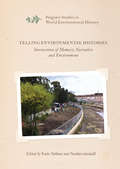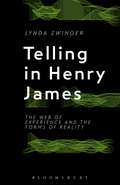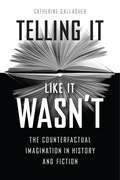- Table View
- List View
Television Sitcom and Cultural Crisis (Routledge Advances in Television Studies)
This volume demonstrates that television comedies are conduits through which we might resist normative ways of thinking about cultural crises.By drawing on Gramscian notion of crisis and the understanding that crises are overlapping, interconnected, and mutually constitutive, the essays in this collection demonstrate that situation comedies do more than make us laugh; they also help us understand the complexities of our social world’s moments of crisis. Each chapter takes up the televisual representation of a modern cultural crisis in a contemporary sitcom and is grounded in the extensive body of literature that suggests that levity is a powerful mechanism to make sense of and cope with these difficult cultural experiences.Divided into thematic sections that highlight crises of institutions and systems, identity and representation, and speculation and futurism, this book will interest scholars of media and cultural studies, political economy, communication studies, and humor studies.
Television’s Streaming Wars (Routledge Advances in Television Studies)
by Arienne Ferchaud Jennifer M. ProffittThis volume addresses contemporary debates and trends regarding the production and distribution, content, and audience engagement with the television streaming industry. The book interrogates the economics and structure of the industry, questions the types and diversity of content perpetuated on streaming services, and addresses how audiences engage with content from US and global perspectives and within various research paradigms. Chapters address television streaming wars, including the debates and trends in terms of its production and competition, diversity and growth of programming, and audience consumption, focusing on multiple platforms, content, and users. This timely and creative volume will interest students and scholars working in television studies, media industry studies, popular culture studies, audience studies, media psychology, critical cultural studies and media economics.
Television’s Streaming Wars (Routledge Advances in Television Studies)
This volume addresses contemporary debates and trends regarding the production and distribution, content, and audience engagement with the television streaming industry. The book interrogates the economics and structure of the industry, questions the types and diversity of content perpetuated on streaming services, and addresses how audiences engage with content from US and global perspectives and within various research paradigms. Chapters address television streaming wars, including the debates and trends in terms of its production and competition, diversity and growth of programming, and audience consumption, focusing on multiple platforms, content, and users. This timely and creative volume will interest students and scholars working in television studies, media industry studies, popular culture studies, audience studies, media psychology, critical cultural studies and media economics.
Tell It Like It Is: A Guide to Clear and Honest Writing
by Roy Peter ClarkAmerica's favorite writing coach and bestselling author returns with an "indispensable" guide (Diana K. Sugg, Pulitzer Prize-winning reporter) to writing clearly and honestly in a world full of lies, propaganda, and misinformation. The darker and more dystopian the future appears, the more influential public writers become. But with so much content vying for our attention, and so much misinformation and propaganda polluting public discourse, how can writers break through the noise to inform an increasingly busy, stressed, and overwhelmed audience? In Tell It Like It Is, bestselling author, writing coach, and teacher Roy Peter Clark offers a succinct and practical guide to writing with clarity, honesty, and conviction. By analyzing stellar writing samples from a diverse collection of public writers, Clark highlights and explains the tools journalists, scientists, economists, fact-checkers, even storytellers use to engage, inform, and hook readers, and how best to deploy them in a variety of contexts. In doing so, he provides answers to some of the most pressing questions facing writers today: How do I make hard facts—about pandemics, wars, natural disasters, social justice—easy reading? How do I get readers to pay attention to what they need to know? How do I help contribute to a culture of writing that combats misinformation and propaganda? How do I instill hope into the hearts and minds of readers? With Clark's trademark wit, insight, and compassion, Tell It Like It Is offers a uniquely practical and engaging guide to public writing in unprecedented times—and an urgently needed remedy for a dangerously confused world.
Tell Me Africa: An Approach to African Literature
by James OlneyJames Olney demonstrates that autobiography, because it provides the most direct narrative enactments of the ways, motives, and beliefs of a culture, is an excellent way to approach African literature. After a general discussion of the African ethos, each chapter takes up the "autobiographical" literature of a specific group in African society and treats it as both an expression of a personal vision and as a revelation of a permeating social reality.Originally published in 1974.The Princeton Legacy Library uses the latest print-on-demand technology to again make available previously out-of-print books from the distinguished backlist of Princeton University Press. These editions preserve the original texts of these important books while presenting them in durable paperback and hardcover editions. The goal of the Princeton Legacy Library is to vastly increase access to the rich scholarly heritage found in the thousands of books published by Princeton University Press since its founding in 1905.
Tell Me No Lies: Investigative Journalism and its Triumphs
by John PilgerTell Me No Lies is a celebration of the very best investigative journalism, and includes writing by some of the greatest practitioners of the craft: Seymour Hersh on the My Lai massacre; Paul Foot on the Lockerbie cover-up; Wilfred Burchett, the first Westerner to enter Hiroshima following the atomic bombing; Israeli journalist Amira Hass, reporting from the Gaza Strip in the 1990s; Gunter Wallraff, the great German undercover reporter; Jessica Mitford on 'The American Way of Death'; Martha Gelhorn on the liberation of the death camp at Dachau. The book - a selection of articles, broadcasts and books extracts that revealed important and disturbing truths - ranges from across many of the critical events, scandals and struggles of the past fifty years. Along the way it bears witness to epic injustices committed against the peoples of Vietnam, Cambodia, East Timor and Palestine. John Pilger sets each piece of reporting in its context and introduces the collection with a passionate essay arguing that the kind of journalism he celebrates here is being subverted by the very forces that ought to be its enemy. Taken as a whole, the book tells an extraordinary 'secret history' of the modern era. It is also a call to arms to journalists everywhere - before it is too late.
Teller of the Unexpected: The Life of Roald Dahl, An Unofficial Biography
by Matthew DennisonBook of the Week on Radio 4, and in the Observer, Sunday Times, Daily Mail and The Week 'Riveting, and immaculately written' Sunday Telegraph 'A superb psychological study of a literary genius' Business Post 'A rounded picture... and gets to Dahl's flawed, human core' Country Life 'Crisply done and well-judged' TLSRoald Dahl was one of the world's greatest storytellers. He conceived his vocation as one as intrepid as that of any explorer and, in his writing for children, he was able to tap into a child's viewpoint throughout his life. He crafted tales that were exotic in scenario, frequently invested with a moral, and filled with vibrant characters that endure in public imagination to the present day.In this brand-new biogrpahy, Matthew Dennison re-evaluates the received narrative surrounding Dahl – that of school sporting hero, daredevil pilot, and wartime spy-turned-author – and examines surviving primary resources as well as Dahl's extensive literary output to tell the story of a man who identified as a rule-breaker, an iconoclast and a romantic, both insider and outsider, hero and child's friend.
Tellers and Listeners: The Narrative Imagination (Bloomsbury Academic Collections: English Literary Criticism)
by Barbara HardyNature, not art, makes us all story-tellers. Daily and nightly we devise fictions and chronicles, calling some of them daydreams or dreams, some of them nightmares, some of them truths, records, reports and plans. The object of this book is to look at these natural narrative forms and themes, which have been neglected by critics but recognized by narrative artists, using literary criticism in order to argue the limits and limitations of literature. Although Hardy's suggestions about narrative apply broadly to all artistic forms, in the second part of the book she approaches the subject through a detailed analysis of three authors, Dickens, Hardy and Joyce, all profound and far-reaching analysts of narrative structures and values.
Tellers, Tales, and Translation in Chaucer's Canterbury Tales
by Warren GinsbergTwo features distinguish the Canterbury Tales from other medieval collections of stories: the interplay among the pilgrims and the manner in which the stories fit their narrators. In his new book, Warren Ginsberg argues that Chaucer often linked tellers and tales by recasting a coordinating idea or set of concerns in each of the blocks of text that make up a 'Canterbury' performance. For the Clerk, the idea is transition, for the Merchant it is revision and reticence, for the Miller it is repetition, for the Franklin it is interruption and elision, for the Wife of Bath it is self-authorship, for the Pardoner it is misdirection and subversion. The parts connect because they translate one another. By expressing the same concept differently, the portraits of the pilgrims in the "General Prologue," the introductions and epilogues to the tales they tell, and the tales themselves become intra-lingual translations that begin to act like metaphors. When brought together by readers, they give the ensemble its inner cohesiveness and reveal what Walter Benjamin called modes of meaning. Chaucer also restaged events across his poem. They too become intra-lingual translations. Together with the linking passages that precede and follow a story, these episodes are the ligaments that stabilize the Tales and underwrite its remarkable elasticity. As much as the conceits that frame the work, the pilgrimage and the tale-telling contest, Chaucer's internal translations guided the construction of his masterpiece and the way his audiences have continued to read it.
Telling About Society (Chicago Guides to Writing, Editing, and Publishing)
by Howard S. BeckerI Remember, one of French writer Georges Perec’s most famous pieces, consists of 480 numbered paragraphs—each just a few short lines recalling a memory from his childhood. The work has neither a beginning nor an end. Nor does it contain any analysis. But it nonetheless reveals profound truths about French society during the 1940s and 50s. Taking Perec’s book as its cue, Telling About Society explores the unconventional ways we communicate what we know about society to others. The third in distinguished teacher Howard Becker’s best-selling series of writing guides for social scientists, the book explores the many ways knowledge about society can be shared and interpreted through different forms of telling—fiction, films, photographs, maps, even mathematical models—many of which remain outside the boundaries of conventional social science. Eight case studies, including the photographs of Walker Evans, the plays of George Bernard Shaw, the novels of Jane Austen and Italo Calvino, and the sociology of Erving Goffman, provide convincing support for Becker’s argument: that every way of telling about society is perfect—for some purpose. The trick is, as Becker notes, to discover what purpose is served by doing it this way rather than that. With Becker’s trademark humor and eminently practical advice, Telling About Society is an ideal guide for social scientists in all fields, for artists interested in saying something about society, and for anyone interested in communicating knowledge in unconventional ways.
Telling About Society (Chicago Guides to Writing, Editing, and Publishing)
by Howard S. BeckerI Remember, one of French writer Georges Perec’s most famous pieces, consists of 480 numbered paragraphs—each just a few short lines recalling a memory from his childhood. The work has neither a beginning nor an end. Nor does it contain any analysis. But it nonetheless reveals profound truths about French society during the 1940s and 50s. Taking Perec’s book as its cue, Telling About Society explores the unconventional ways we communicate what we know about society to others. The third in distinguished teacher Howard Becker’s best-selling series of writing guides for social scientists, the book explores the many ways knowledge about society can be shared and interpreted through different forms of telling—fiction, films, photographs, maps, even mathematical models—many of which remain outside the boundaries of conventional social science. Eight case studies, including the photographs of Walker Evans, the plays of George Bernard Shaw, the novels of Jane Austen and Italo Calvino, and the sociology of Erving Goffman, provide convincing support for Becker’s argument: that every way of telling about society is perfect—for some purpose. The trick is, as Becker notes, to discover what purpose is served by doing it this way rather than that. With Becker’s trademark humor and eminently practical advice, Telling About Society is an ideal guide for social scientists in all fields, for artists interested in saying something about society, and for anyone interested in communicating knowledge in unconventional ways.
Telling About Society (Chicago Guides to Writing, Editing, and Publishing)
by Howard S. BeckerI Remember, one of French writer Georges Perec’s most famous pieces, consists of 480 numbered paragraphs—each just a few short lines recalling a memory from his childhood. The work has neither a beginning nor an end. Nor does it contain any analysis. But it nonetheless reveals profound truths about French society during the 1940s and 50s. Taking Perec’s book as its cue, Telling About Society explores the unconventional ways we communicate what we know about society to others. The third in distinguished teacher Howard Becker’s best-selling series of writing guides for social scientists, the book explores the many ways knowledge about society can be shared and interpreted through different forms of telling—fiction, films, photographs, maps, even mathematical models—many of which remain outside the boundaries of conventional social science. Eight case studies, including the photographs of Walker Evans, the plays of George Bernard Shaw, the novels of Jane Austen and Italo Calvino, and the sociology of Erving Goffman, provide convincing support for Becker’s argument: that every way of telling about society is perfect—for some purpose. The trick is, as Becker notes, to discover what purpose is served by doing it this way rather than that. With Becker’s trademark humor and eminently practical advice, Telling About Society is an ideal guide for social scientists in all fields, for artists interested in saying something about society, and for anyone interested in communicating knowledge in unconventional ways.
Telling About Society (Chicago Guides to Writing, Editing, and Publishing)
by Howard S. BeckerI Remember, one of French writer Georges Perec’s most famous pieces, consists of 480 numbered paragraphs—each just a few short lines recalling a memory from his childhood. The work has neither a beginning nor an end. Nor does it contain any analysis. But it nonetheless reveals profound truths about French society during the 1940s and 50s. Taking Perec’s book as its cue, Telling About Society explores the unconventional ways we communicate what we know about society to others. The third in distinguished teacher Howard Becker’s best-selling series of writing guides for social scientists, the book explores the many ways knowledge about society can be shared and interpreted through different forms of telling—fiction, films, photographs, maps, even mathematical models—many of which remain outside the boundaries of conventional social science. Eight case studies, including the photographs of Walker Evans, the plays of George Bernard Shaw, the novels of Jane Austen and Italo Calvino, and the sociology of Erving Goffman, provide convincing support for Becker’s argument: that every way of telling about society is perfect—for some purpose. The trick is, as Becker notes, to discover what purpose is served by doing it this way rather than that. With Becker’s trademark humor and eminently practical advice, Telling About Society is an ideal guide for social scientists in all fields, for artists interested in saying something about society, and for anyone interested in communicating knowledge in unconventional ways.
Telling About Society (Chicago Guides to Writing, Editing, and Publishing)
by Howard S. BeckerI Remember, one of French writer Georges Perec’s most famous pieces, consists of 480 numbered paragraphs—each just a few short lines recalling a memory from his childhood. The work has neither a beginning nor an end. Nor does it contain any analysis. But it nonetheless reveals profound truths about French society during the 1940s and 50s. Taking Perec’s book as its cue, Telling About Society explores the unconventional ways we communicate what we know about society to others. The third in distinguished teacher Howard Becker’s best-selling series of writing guides for social scientists, the book explores the many ways knowledge about society can be shared and interpreted through different forms of telling—fiction, films, photographs, maps, even mathematical models—many of which remain outside the boundaries of conventional social science. Eight case studies, including the photographs of Walker Evans, the plays of George Bernard Shaw, the novels of Jane Austen and Italo Calvino, and the sociology of Erving Goffman, provide convincing support for Becker’s argument: that every way of telling about society is perfect—for some purpose. The trick is, as Becker notes, to discover what purpose is served by doing it this way rather than that. With Becker’s trademark humor and eminently practical advice, Telling About Society is an ideal guide for social scientists in all fields, for artists interested in saying something about society, and for anyone interested in communicating knowledge in unconventional ways.
Telling About Society (Chicago Guides to Writing, Editing, and Publishing)
by Howard S. BeckerI Remember, one of French writer Georges Perec’s most famous pieces, consists of 480 numbered paragraphs—each just a few short lines recalling a memory from his childhood. The work has neither a beginning nor an end. Nor does it contain any analysis. But it nonetheless reveals profound truths about French society during the 1940s and 50s. Taking Perec’s book as its cue, Telling About Society explores the unconventional ways we communicate what we know about society to others. The third in distinguished teacher Howard Becker’s best-selling series of writing guides for social scientists, the book explores the many ways knowledge about society can be shared and interpreted through different forms of telling—fiction, films, photographs, maps, even mathematical models—many of which remain outside the boundaries of conventional social science. Eight case studies, including the photographs of Walker Evans, the plays of George Bernard Shaw, the novels of Jane Austen and Italo Calvino, and the sociology of Erving Goffman, provide convincing support for Becker’s argument: that every way of telling about society is perfect—for some purpose. The trick is, as Becker notes, to discover what purpose is served by doing it this way rather than that. With Becker’s trademark humor and eminently practical advice, Telling About Society is an ideal guide for social scientists in all fields, for artists interested in saying something about society, and for anyone interested in communicating knowledge in unconventional ways.
Telling America's Story to the World: Literature, Internationalism, Cultural Diplomacy (Oxford Studies in American Literary History)
by Harilaos StecopoulosTelling America's Story to the World argues that state and state-affiliated cultural diplomacy contributed to the making of postwar US literature. Highlighting the role of liberal internationalism in US cultural outreach, Harilaos Stecopoulos contends that the state mainly sent authors like Ralph Ellison, Robert Frost, William Faulkner, Langston Hughes, and Maxine Hong Kingston overseas not just to demonstrate the achievements of US civilization but also to broadcast an American commitment to international cross-cultural connection. Those writers-cum-ambassadors may not have helped the state achieve its propaganda goals-indeed, this rarely proved the case-but they did find their assignments an opportunity to ponder the international meanings and possibilities of US literature. For many of those figures, courting foreign publics inspired a reevaluation of the scope and form of their own literary projects. Testifying to the inadvertent yet integral role of cultural diplomacy in the worlding of US letters, works like The Mansion (1959), Life Studies (1959), "Cultural Exchange" (1961, 1967), Tripmaster Monkey: His Fake Book (1989), and Three Days Before the Shooting... (2010) reimagine US literature in a mobile, global, and distinctly political register.
Telling America's Story to the World: Literature, Internationalism, Cultural Diplomacy (Oxford Studies in American Literary History)
by Harilaos StecopoulosTelling America's Story to the World argues that state and state-affiliated cultural diplomacy contributed to the making of postwar US literature. Highlighting the role of liberal internationalism in US cultural outreach, Harilaos Stecopoulos contends that the state mainly sent authors like Ralph Ellison, Robert Frost, William Faulkner, Langston Hughes, and Maxine Hong Kingston overseas not just to demonstrate the achievements of US civilization but also to broadcast an American commitment to international cross-cultural connection. Those writers-cum-ambassadors may not have helped the state achieve its propaganda goals-indeed, this rarely proved the case-but they did find their assignments an opportunity to ponder the international meanings and possibilities of US literature. For many of those figures, courting foreign publics inspired a reevaluation of the scope and form of their own literary projects. Testifying to the inadvertent yet integral role of cultural diplomacy in the worlding of US letters, works like The Mansion (1959), Life Studies (1959), "Cultural Exchange" (1961, 1967), Tripmaster Monkey: His Fake Book (1989), and Three Days Before the Shooting... (2010) reimagine US literature in a mobile, global, and distinctly political register.
Telling Details: Chinese Fiction, World Literature (Literary Criticism and Cultural Theory)
by Jiwei XiaoWhat is a detail? How is it different from xijie, its Chinese counterpart? Is "reading for the details" fundamentally different from "reading for the plot"? Did xijie xiaoshuo, the Chinese novel of details, give the world its earliest form of modern fiction? Inspired by studies of vision and modernity as well as cinema, this book gazes out on the larger world through the small aperture of the detail, highlighting how concrete literary minutiae become "telling" as they reveal the dynamics of seeing and hearing, the vibrations of the mind, the complexity of the everyday, and the imperative to recognize the minute, the humble, and the hidden. In a strain of masterpieces of xijie xiaoshuo, such details play a key role in pivoting the novel from didacticism towards a capacious modern form. Examining the Chinese detail as both a common idiom and a unique concept, and extrapolating it from individual works to the culture at large, reveals under-explored areas of the Chinese novel: its psychological depths, its connections with other genres and forms, its partaking in Chinese material life and capitalist modernity, as well as repressions and difficulties surrounding its reception in national and international contexts. With carefully chosen case studies, Xiao’s book not only exemplifies the value of deep reading in approaching complex works of Chinese fiction as world literature, it also throws light on the aesthetics and politics of "the unseen," which has become central to a humanist tradition that flows across literature, cinema, and other art forms.
Telling Details: Chinese Fiction, World Literature (Literary Criticism and Cultural Theory)
by Jiwei XiaoWhat is a detail? How is it different from xijie, its Chinese counterpart? Is "reading for the details" fundamentally different from "reading for the plot"? Did xijie xiaoshuo, the Chinese novel of details, give the world its earliest form of modern fiction? Inspired by studies of vision and modernity as well as cinema, this book gazes out on the larger world through the small aperture of the detail, highlighting how concrete literary minutiae become "telling" as they reveal the dynamics of seeing and hearing, the vibrations of the mind, the complexity of the everyday, and the imperative to recognize the minute, the humble, and the hidden. In a strain of masterpieces of xijie xiaoshuo, such details play a key role in pivoting the novel from didacticism towards a capacious modern form. Examining the Chinese detail as both a common idiom and a unique concept, and extrapolating it from individual works to the culture at large, reveals under-explored areas of the Chinese novel: its psychological depths, its connections with other genres and forms, its partaking in Chinese material life and capitalist modernity, as well as repressions and difficulties surrounding its reception in national and international contexts. With carefully chosen case studies, Xiao’s book not only exemplifies the value of deep reading in approaching complex works of Chinese fiction as world literature, it also throws light on the aesthetics and politics of "the unseen," which has become central to a humanist tradition that flows across literature, cinema, and other art forms.
Telling Environmental Histories: Intersections of Memory, Narrative and Environment (Palgrave Studies in World Environmental History)
by Katie Holmes Heather GoodallThis collection explores the intersections of oral history and environmental history. Oral history offers environmental historians the opportunity to understand the ways people’s perceptions, experiences and beliefs about environments change over time. In turn, the insights of environmental history challenge oral historians to think more critically about the ways an active, more-than-human world shapes experiences and people. The integration of these approaches enables us to more fully and critically understand the ways cultural and individual memory and experience shapes human interactions with the more-than-human world, just as it enables us to identify the ways human memory, identity and experience is moulded by the landscapes and environments in which people live and labour. It includes contributions from Australia, India, the UK, Canada and the USA.
Telling in Henry James: The Web of Experience and the Forms of Reality
by Lynda ZwingerTelling in Henry James argues that James's contribution to narrative and narrative theories is a lifelong exploration of how to "tell," but not, as Douglas has it in "The Turn of the Screw" in any "literal, vulgar way." James's fiction offers multiple, and often contradictory, reading (in)directions. Zwinger's overarching contention is that the telling detail is that which cannot be accounted for with any single critical or theoretical lens-that reading James is in some real sense a reading of the disquietingly inassimilable "fictional machinery." The analyses offered by each of the six chapters are grounded in close reading and focused on oddments-textual equivalents to the "particles†? James describes as caught in a silken spider web, in a famous analogy used in "The Art of Fiction†? to describe the kind of "consciousness†? James wants his fiction to present to the reader.Telling in Henry James attends to the sheer fun of James's wit and verbal dexterity, to the cognitive tune-up offered by the complexities and nuances of his precise and rhythmic syntax, and to the complex and contradictory contrapuntal impact of the language on the page, tongue, and ear.
Telling in Henry James: The Web of Experience and the Forms of Reality
by Lynda ZwingerTelling in Henry James argues that James's contribution to narrative and narrative theories is a lifelong exploration of how to "tell," but not, as Douglas has it in "The Turn of the Screw" in any "literal, vulgar way." James's fiction offers multiple, and often contradictory, reading (in)directions. Zwinger's overarching contention is that the telling detail is that which cannot be accounted for with any single critical or theoretical lens-that reading James is in some real sense a reading of the disquietingly inassimilable "fictional machinery." The analyses offered by each of the six chapters are grounded in close reading and focused on oddments-textual equivalents to the “particles” James describes as caught in a silken spider web, in a famous analogy used in “The Art of Fiction” to describe the kind of “consciousness” James wants his fiction to present to the reader.Telling in Henry James attends to the sheer fun of James's wit and verbal dexterity, to the cognitive tune-up offered by the complexities and nuances of his precise and rhythmic syntax, and to the complex and contradictory contrapuntal impact of the language on the page, tongue, and ear.
Telling It Like It Wasn’t: The Counterfactual Imagination in History and Fiction
by Catherine GallagherInventing counterfactual histories is a common pastime of modern day historians, both amateur and professional. We speculate about an America ruled by Jefferson Davis, a Europe that never threw off Hitler, or a second term for JFK. These narratives are often written off as politically inspired fantasy or as pop culture fodder, but in Telling It Like It Wasn’t, Catherine Gallagher takes the history of counterfactual history seriously, pinning it down as an object of dispassionate study. She doesn’t take a moral or normative stand on the practice, but focuses her attention on how it works and to what ends—a quest that takes readers on a fascinating tour of literary and historical criticism. Gallagher locates the origins of contemporary counterfactual history in eighteenth-century Europe, where the idea of other possible historical worlds first took hold in philosophical disputes about Providence before being repurposed by military theorists as a tool for improving the art of war. In the next century, counterfactualism became a legal device for deciding liability, and lengthy alternate-history fictions appeared, illustrating struggles for historical justice. These early motivations—for philosophical understanding, military improvement, and historical justice—are still evident today in our fondness for counterfactual tales. Alternate histories of the Civil War and WWII abound, but here, Gallagher shows how the counterfactual habit of replaying the recent past often shapes our understanding of the actual events themselves. The counterfactual mode lets us continue to envision our future by reconsidering the range of previous alternatives. Throughout this engaging and eye-opening book, Gallagher encourages readers to ask important questions about our obsession with counterfactual history and the roots of our tendency to ask “What if…?”
Telling It Like It Wasn’t: The Counterfactual Imagination in History and Fiction
by Catherine GallagherInventing counterfactual histories is a common pastime of modern day historians, both amateur and professional. We speculate about an America ruled by Jefferson Davis, a Europe that never threw off Hitler, or a second term for JFK. These narratives are often written off as politically inspired fantasy or as pop culture fodder, but in Telling It Like It Wasn’t, Catherine Gallagher takes the history of counterfactual history seriously, pinning it down as an object of dispassionate study. She doesn’t take a moral or normative stand on the practice, but focuses her attention on how it works and to what ends—a quest that takes readers on a fascinating tour of literary and historical criticism. Gallagher locates the origins of contemporary counterfactual history in eighteenth-century Europe, where the idea of other possible historical worlds first took hold in philosophical disputes about Providence before being repurposed by military theorists as a tool for improving the art of war. In the next century, counterfactualism became a legal device for deciding liability, and lengthy alternate-history fictions appeared, illustrating struggles for historical justice. These early motivations—for philosophical understanding, military improvement, and historical justice—are still evident today in our fondness for counterfactual tales. Alternate histories of the Civil War and WWII abound, but here, Gallagher shows how the counterfactual habit of replaying the recent past often shapes our understanding of the actual events themselves. The counterfactual mode lets us continue to envision our future by reconsidering the range of previous alternatives. Throughout this engaging and eye-opening book, Gallagher encourages readers to ask important questions about our obsession with counterfactual history and the roots of our tendency to ask “What if…?”
Telling It Like It Wasn’t: The Counterfactual Imagination in History and Fiction
by Catherine GallagherInventing counterfactual histories is a common pastime of modern day historians, both amateur and professional. We speculate about an America ruled by Jefferson Davis, a Europe that never threw off Hitler, or a second term for JFK. These narratives are often written off as politically inspired fantasy or as pop culture fodder, but in Telling It Like It Wasn’t, Catherine Gallagher takes the history of counterfactual history seriously, pinning it down as an object of dispassionate study. She doesn’t take a moral or normative stand on the practice, but focuses her attention on how it works and to what ends—a quest that takes readers on a fascinating tour of literary and historical criticism. Gallagher locates the origins of contemporary counterfactual history in eighteenth-century Europe, where the idea of other possible historical worlds first took hold in philosophical disputes about Providence before being repurposed by military theorists as a tool for improving the art of war. In the next century, counterfactualism became a legal device for deciding liability, and lengthy alternate-history fictions appeared, illustrating struggles for historical justice. These early motivations—for philosophical understanding, military improvement, and historical justice—are still evident today in our fondness for counterfactual tales. Alternate histories of the Civil War and WWII abound, but here, Gallagher shows how the counterfactual habit of replaying the recent past often shapes our understanding of the actual events themselves. The counterfactual mode lets us continue to envision our future by reconsidering the range of previous alternatives. Throughout this engaging and eye-opening book, Gallagher encourages readers to ask important questions about our obsession with counterfactual history and the roots of our tendency to ask “What if…?”

